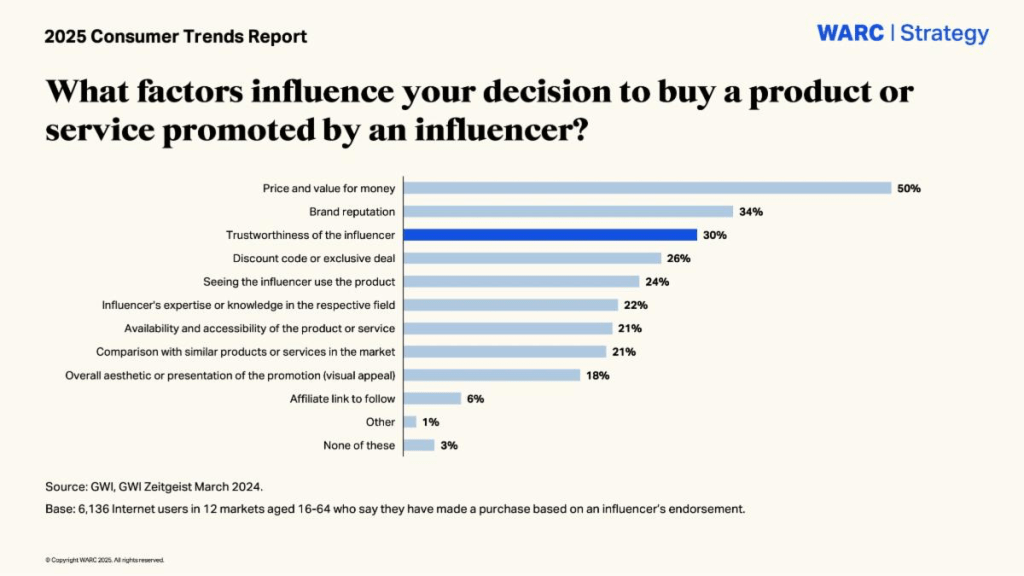LONDON, UK – In a time of persistent economic challenges and evolving consumer behaviors, WARC has unveiled its 2025 Global Consumer Trends report, shedding light on the shifting priorities, motivations, and decision-making factors shaping the global marketplace. The study, which combines extensive data from GWI surveys across 54 markets with WARC’s proprietary research and case studies, outlines five major trends that are set to define consumer choices across categories and regions in the year ahead.
Stephanie Siew, Senior Research Executive, WARC, says: “Amidst persisting economic uncertaintyand the unpredictability around US trade tariffs, consumers are becoming more intentional in their spending and taking greater control over different aspects of their lives, particularly in the way they consume information, manage their wellbeing, and connect with others.”
WARC’s report delivers insights aimed at helping brands adapt and thrive in this shifting landscape. The following are the five key consumer trends identified:
1. The Widening Cost-of-Living Gap
Economic disparity is widening, with spending power increasingly polarized. Data reveals that the top 10% of US households now account for nearly half of all consumer spending, a trend expected to intensify as tariffs push essential goods further out of reach for lower-income groups. In fact, 55% of low-income consumers globally prefer cheaper own-brand alternatives over familiar branded products compared to just 40% of higher-income consumers.
Faris Yakob, Co-founder of Genius Steals, observes: “Since the ‘middle class’ is bifurcating into the haves and have-nots, many companies are reshuffling to serve the top twenty percent and the top one percent within that. The lower echelons are offered value alternatives and those with money are tempted to spend it on various levels of luxury as those companies pivot to lower volume / higher margin business models.”
Implication for brands: Reassess target markets, review pricing strategies and tailor communications to match evolving value perceptions across socioeconomic segments.
2. The Growing Credibility of Individual Creators
As trust in traditional media wanes, individual creators and influencers are emerging as credible voices in consumers’ lives. Nearly half (47%) of social media users have made a purchase based on influencer recommendations over the past year, with Gen Z leading the trend.
Today, 57% of consumers source news from social media, outpacing national TV (52%) and news websites (49%). This trust in authenticity over institutional messaging is reshaping the brand discovery journey.
Sapna Chadha, VP of SEA and South Asia Frontier, Google, says: “Consumers are going to creators to discover information about brands. The difference now is that they are moving from passive discovery to really immersing themselves in an entirely new shopping experience, which encompasses video.”
Implication for brands: Collaborate with trusted creators, elevate in-house talent and ensure values alignment in both paid and earned media strategies.

3. The Humanisation of AI
AI agents are transitioning from novelty to utility. Tools like OpenAI’s Operator and Google’s Project Mariner are beginning to make autonomous decisions on behalf of users. Currently, 24% of consumers say they’re comfortable with AI agents shopping for them – a number rising to nearly a third among Gen Z.
ChatGPT remains the most used AI tool, but others like Google Gemini and Microsoft Copilot are gaining ground. Four in ten consumers already trust AI to schedule appointments, and nearly one third value the efficiency and round-the-clock availability of AI chatbots.
Debra Aho Williamson, Founder and chief analyst, Sonata Insights notes: “Soon, consumers will not even need to go to an AI platform to do what they do today. Instead, they will have an AI agent perform a task on their behalf, and the results will be delivered to them.”
Implication for brands: Blend AI and human touchpoints thoughtfully and optimise visibility in AI-powered search environments to ensure brand presence in machine-driven decisions.

4. A Proactive Approach to Health
Health consciousness is no longer a trend, it’s a full blown lifestyle. From food choices to wearables, consumers are actively prioritising wellbeing and preventative care. In 2024, 31% of consumers purchased vitamins or supplements, up from 24% in 2022. And 77% express concern about the risks associated with ultra-processed foods.
The shift is particularly pronounced among millennials and Gen Z, who are spearheading a movement toward functional nutrition, mindfulness, and holistic health practices.
Alberto Romano, Global Consumer & Shopper Planning Collaboration Manager, Diageo, says: “Whether it is wellness-orientated food or clothing designed for comfort and emotional wellbeing, brands have the opportunity to shape the future by carving out unique and meaningful roles and purposes that resonate deeply with consumers’ wellness lifestyles.”
Implication for brands: Highlight nutritional benefits, offer ‘better-for-you’ options, and communicate clearly and authentically to resonate with wellness-conscious consumers even in traditionally indulgent categories.
5. Rewriting the Rules of Social Connection
A generational shift is redefining how people gather, with younger consumers leaning into interest-based activities as more meaningful alternatives to conventional socializing. Data from GWI reveals that half of Gen Z and millennials play board games at least once a month, favouring strategy, trivia and party games.
Meanwhile, rising interest in health and fitness, outdoor adventures, and niche hobbies both online and offline is reshaping the way communities form. Over half (53%) of consumers attended a festival or in-person event in the past year, underlining a renewed appetite for shared, real world experiences.
Colleen Ryan, Partner, TRA, says: “Ultimately, the way people build connections has changed. We have moved from traditional systems to connecting with people whose interests are shared. For brands, this presents a challenge but also an opportunity, a middle ground on which to build connection, a space in between.”
Implication for brands: Create and participate in passion-led spaces through experiential activations, branded events, or platform partnerships that foster deeper, more personal engagement.
‘Part of WARC’s Evolution of Marketing programme, WARC subscribers can read the 2025 Consumer Trends report in full here.








